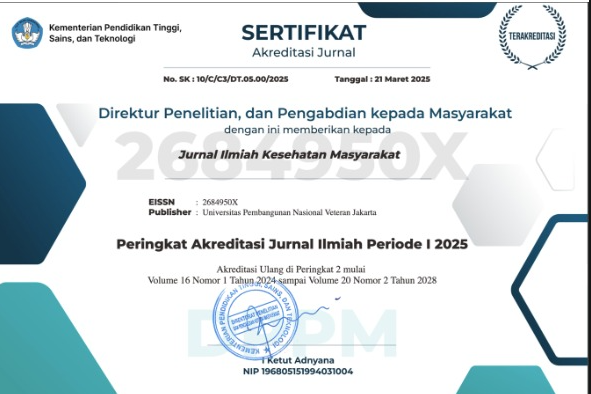Kajian Kesiapan Penerapan Keselamatan dan Kesehatan Kerja di Puskesmas Bagan Punak Kabupaten Rokan Hilir Provinsi Riau
Abstract
Abstrak
Latar Belakang :. Dalam penerapan Keselamatan Kesehatan dan Kerja (K3), dibutuhkan beberapa faktor yang perlu dipenuhi seperti unsur internal dan eksternal penerapan K3. Tujuan penelitian ini adalah untuk melakukan analisis kesiapan penerapan K3 di Puskesmas Bagan Punak Kecamatan Bangko, Kabupaten Rokan Hilir Provinsi Riau.
Metode: Penelitian ini menggunakan metode kualitatif melalui wawancara mendalam, observasi dan telaah dokumen. Informan utama dalam penelitian ini sebanyak tiga orang yang terdiri dari Kepala Puskesmas, Dokter penanggung jawab terhadap K3 dan Pegawai Puskesmas, sedangkan informan pendukung sebanyak dua orang yang terdiri dari Kepala Dinas Kesehatan dan Penanggung Jawab Program K3. Analisis kesiapan penerapan K3 di Puskesmas Bagan Punak ditinjau dari aspek internal dan eksternal.
Hasil: Kendala internal berupa belum adanya sumber daya kesehatan yang berlatar belakang pendidikan K3, tidak adanya rancangan dana untuk penerapan K3, kurangnya ketersediaan peralatan yang sesuai dengan peraturan pemerintah, serta kurangnya tenaga kesehatan dalam memahami buku pedoman yang telah dirancang. Kendala di eksternalnya adalah belum diterapkannya kebijakan yang harus diikuti dan kurangnya monitoring dari pihak dinas kesehatan ke puskesmas setelah dilaksanakan pelatihan untuk tenaga Kesehatan di puskesmas khususnya kepada petugas penanggung jawab K3.
Kesimpulan: Disarankan kepada Puskesmas Bagan Punak adalah mengusulkan tenaga yang akan menjadi penanggung jawab K3 dan dibentuknya Tim K3 di Fasyankes, berkoordinasi dengan Dinas Kesehatan, menambah ketersediaan alat K3, dan menetapkan kebijakan penerapan K3 di puskesmas.
Study of The Readiness Assessment For Occupational Health and Safety Implementation at Bagan Punak Health Center Rohil District Riau Province
Abstract
Background: In the implementation of Occupational Safety and Health (K3), several factors are needed that need to be fulfilled, such as the internal and external elements of the application of K3. The purpose of this study was to analyze the readiness for the application of K3 at the Bagan Punak Health Center, Bangko District, Rokan Hilir Regency, Riau Province.
Methods: This study uses qualitative methods through in-depth interviews, observation and document review. The main informants in this study were three people consisting of the Head of the Health Center, the Doctor in charge of K3 and Health Center employees, while the supporting informants were two people consisting of the Head of the Health Service and the Person in Charge of the K3 Program. Analysis of readiness for the application of K3 at the Bagan Punak Health Center in terms of internal and external aspects.
Result: Internal constraints in the form of the absence of health resources with an OHS educational background, the absence of a design fund for the implementation of K3, the lack of availability of equipment in accordance with government regulations, and the lack of health workers in understanding the designed guidebook. Meanwhile, the external constraints are that the policies that must be followed have not been implemented and the lack of monitoring from the health office to the puskesmas after training for health workers at the puskesmas, especially the officers in charge of K3.
Conclusion: Suggested to the Bagan Punak Health Center are proposing personnel who will be in charge of K3 and the formation of an K3 Team at the Health Facilities, coordinating with the Health Office, increasing the availability of K3 equipment, and establishing policies for implementing K3 at the puskesmas.
References
Permenkes RI. Peraturan Menteri Kesehatan Republik Indonesia Nomor 100 Tahun 2015 tentang Pos Upaya Kesehatan Kerja (UKK). Jakarta, Indonesia;
Kemenkes RI. Peraturan Menteri Kesehatan Republik Indonesia Nomor 52 Tahun 2018 Tentang Keselamatan Dan Kesehatan Kerja di Fasilitas Pelayanan Kesehatan. Jakarta; 2018.
Prasetyowati JD, Denny HM, Suroto S. Analisis Penerapan Keselamatan Dan Kesehatan Kerja (K3) Puskesmas Di Kabupaten Semarang Menggunakan Re-Aim Framework. J Formil (Forum Ilmiah) Kesmas Respati. 2019;4(1):1.
Annisa Nanda Asri, Rafiah Maharani Pulungan AMF. Hubungan Lingkungan Kerja dengan Gejala Sick Building Syndrome pada Pegawai BPJS Kesehatan Depok Tahun 2019. JPH RECODE. 2019;3(1):44–55.
Salamate GA, Rattu AJM, J. N. Pangemanan. Planning Analysis of Health Human Resource in Health Office Southeast Minahasa District. Jikmu. 2014;4:625–33.
Alamsyah D. Manajemen Pelayanan Kesehatan. Yogyakarta: Nuha Medika; 2011.
Arikhman.R. Analysis Of The Implementation Of Safety and Health In Occupation Safety Programs In Sungai Dareh Regional Public Hospitals. J Kesehat Med Saintika. 2020;7(2):108–13.
Terry G., Rue L. Dasar - Dasar Manajemen. Jakarta: Bumi Aksara; 1992.
Fayren Mongilala W, T Kawatu PA, C Korompis GE. Analisis Pelaksanaan Program Kesehatan Kerja Di Puskesmas Sonder Kabupaten Minahasa. J KESMAS. 2018;7(5).
Bando JJ, Kawatu PAT, Ratag BT, Kesehatan F, Universitas M, Ratulangi S. Gambaran Penerapan Program Keselamatan Dan Kesehatan Kerja Rumah Sakit (K3Rs) Di Rumah Sakit Advent Manado. Kesmas. 2020;9(2):33–40.
Heryant AA, Pulungan RM. Faktor Risiko Kejadian Hipertensi pada Pekerja Konstruksi di Proyek Pembangunan Tol Tahun 2018. J Ilm Kesehat Masyarakat, Ed 1. 2019;11(1):100–16.
Ninla Elmawati Falabiba, Anggaran W, Mayssara A. Abo Hassanin Supervised A, Wiyono B., Ninla Elmawati Falabiba, Zhang YJ, et al. Implementasi Kebijakan dan Kesehatan di Kota Bekasi. Pap Knowl Towar a Media Hist Doc. 2014;5(2):40–51.
Saffanah S, Pulungan RM. Faktor Risiko Gejala Sick Building Syndrome Pada Risk Factors Symptoms of Sick Building Syndrome in. J Ilmu Kesehat. 2017;3(1):8–15.
Wati N, Ramon A, Husin H, Elianto R. Analisis Sistem Manajemen Keselamatan Dan Kesehatan Kerja Di Rumah Sakit Umum Daerah Mukomuko Tahun 2017. J Ilm AVICENNA. 2018;13(3):8–15.
Pulungan RM, Karima UQ. Pembentukan Pos Edukasi PTM (Penyakit Tidak Menular) di Puskesmas Cikulur. Ikraith Abdimas. 2020;3(3):91–6.









.jpg)








